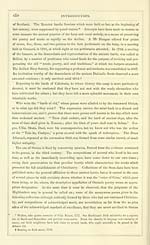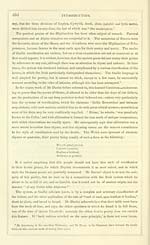Blair Collection > Sar-obair nam bard gaelach, or, The beauties of Gaelic poetry, and lives of the Highland bards > Volume 2
(39)
Download files
Complete book:
Individual page:
Thumbnail gallery: Grid view | List view

INTRODUCTION. xlv
Mac Fhinn.* The authors of some of those ancient compositions are known, as of
Mordubh and Goliath, but many others are anonymous, or of uncertain authorship.
It will scarcely be expected that the question of the authenticity of the poems of Ossian
which so long agitated the literary world, shall be resumed in the pages of this short essay.
The ample proofs of the existence of those poems in the oral record of the unlettered
Highlanders, as well as in several MSS., long before MacPherson undertook the labour
of collecting and translating them, obtained by the searching investigation of the High-
land Society, and of individuals, have, we should think, settled the controversy to the satis-
faction of the unprejudiced. The evidences which the poems were supposed to exhibit of
their recent composition, as urged by Laing and others ignorant of the language, have
been happily overthrown by natives of the country who well understood the originals, while
the correspondence of the chronology of those compositions with the events in Scottish
history, is an extraordinary proof of their being the genuine production of antiquity.
'•'The history of the bards, is perhaps of all others the most extraordinary," is the ex-
pression of an eminent writer on poetry and music ;t and another has said, that " on the
construction of the old Celtic poetry we want much information. "+ Since this wish was
expressed, the subject has been treated by writers qualified by a competent knowledge of
the language. The Triads, which form so curious a record, commemorate Tydain, who
first made an order and regulation for the record of vocal song ; and it is laid down that
there are three requisites for a poetical genius — an eye that can see nature, a heart that
can feel it, and boldness that dares to follow it. In Ireland, Ceanfaela (who flourished
about 500,) we are told, wrote or revised what is called the " uraicepht na neagir," or
rules for poets, a very useful work, since we find there were upwards of 100 kinds of
poetical construction. In ' Anglia Sacra,' mention is made of a Scot who was acquainted
with 100 different sorts of verse, with the modulation of words and syllables to music,
to which letters, figures, poetic feet, tone, and time, were necessary. §
The Triads are a sort of oracular stanzas, composed with much art in three lines.
This triplet form was not unknown to the Highlanders, but it was more peculiarly Welsh,
and appears to be, as is uniformly asserted, the favourite druidic style. It is generally
termed Englyn Milwr, the warrior's song, which points to its use as the " cerdd voliant
prosnachadh," or stimulating address which animated the troops in war. It was in this
measure, doubtless, that the famed Unbeniaeth Prydain, or heroic poem called the Monarchy
of Britain, was composed. This is now lost; but it had a wonderful effect on the hearers,
referring to the pristine glories of the Britons when they held the sovereignty of the
island. It was Eydeyrn, the golden-tongued, in the reign of Gruffudd, Prince of Aber-
fraw 1258-82 who made an analysis of the metres of vocal song, " to be as a record and
a code."|| Those who wish farther information respecting the Welsh bards will be amply
gratified by consulting the elaborate works of Jones and Evans ; it may be sufficient to
* There -were others of the name. Those poems in which matters relative to Christianity are introduced,
which are current in Ireland, were in all probability the composition of that Oisian, who became St
Patrick's disciple.
| Dr Brown. t Pinkerton "the Goth."
S II. p. 21 3. li Owens Dictionary.
Mac Fhinn.* The authors of some of those ancient compositions are known, as of
Mordubh and Goliath, but many others are anonymous, or of uncertain authorship.
It will scarcely be expected that the question of the authenticity of the poems of Ossian
which so long agitated the literary world, shall be resumed in the pages of this short essay.
The ample proofs of the existence of those poems in the oral record of the unlettered
Highlanders, as well as in several MSS., long before MacPherson undertook the labour
of collecting and translating them, obtained by the searching investigation of the High-
land Society, and of individuals, have, we should think, settled the controversy to the satis-
faction of the unprejudiced. The evidences which the poems were supposed to exhibit of
their recent composition, as urged by Laing and others ignorant of the language, have
been happily overthrown by natives of the country who well understood the originals, while
the correspondence of the chronology of those compositions with the events in Scottish
history, is an extraordinary proof of their being the genuine production of antiquity.
'•'The history of the bards, is perhaps of all others the most extraordinary," is the ex-
pression of an eminent writer on poetry and music ;t and another has said, that " on the
construction of the old Celtic poetry we want much information. "+ Since this wish was
expressed, the subject has been treated by writers qualified by a competent knowledge of
the language. The Triads, which form so curious a record, commemorate Tydain, who
first made an order and regulation for the record of vocal song ; and it is laid down that
there are three requisites for a poetical genius — an eye that can see nature, a heart that
can feel it, and boldness that dares to follow it. In Ireland, Ceanfaela (who flourished
about 500,) we are told, wrote or revised what is called the " uraicepht na neagir," or
rules for poets, a very useful work, since we find there were upwards of 100 kinds of
poetical construction. In ' Anglia Sacra,' mention is made of a Scot who was acquainted
with 100 different sorts of verse, with the modulation of words and syllables to music,
to which letters, figures, poetic feet, tone, and time, were necessary. §
The Triads are a sort of oracular stanzas, composed with much art in three lines.
This triplet form was not unknown to the Highlanders, but it was more peculiarly Welsh,
and appears to be, as is uniformly asserted, the favourite druidic style. It is generally
termed Englyn Milwr, the warrior's song, which points to its use as the " cerdd voliant
prosnachadh," or stimulating address which animated the troops in war. It was in this
measure, doubtless, that the famed Unbeniaeth Prydain, or heroic poem called the Monarchy
of Britain, was composed. This is now lost; but it had a wonderful effect on the hearers,
referring to the pristine glories of the Britons when they held the sovereignty of the
island. It was Eydeyrn, the golden-tongued, in the reign of Gruffudd, Prince of Aber-
fraw 1258-82 who made an analysis of the metres of vocal song, " to be as a record and
a code."|| Those who wish farther information respecting the Welsh bards will be amply
gratified by consulting the elaborate works of Jones and Evans ; it may be sufficient to
* There -were others of the name. Those poems in which matters relative to Christianity are introduced,
which are current in Ireland, were in all probability the composition of that Oisian, who became St
Patrick's disciple.
| Dr Brown. t Pinkerton "the Goth."
S II. p. 21 3. li Owens Dictionary.
Set display mode to: Large image | Transcription
Images and transcriptions on this page, including medium image downloads, may be used under the Creative Commons Attribution 4.0 International Licence unless otherwise stated. ![]()
| Early Gaelic Book Collections > Blair Collection > Sar-obair nam bard gaelach, or, The beauties of Gaelic poetry, and lives of the Highland bards > Volume 2 > (39) |
|---|
| Permanent URL | https://digital.nls.uk/75794625 |
|---|
| Description | Vol. II. |
|---|---|
| Shelfmark | Blair.66 |
| Additional NLS resources: | |
| Attribution and copyright: |
|
| Description | A selection of books from a collection of more than 500 titles, mostly on religious and literary topics. Also includes some material dealing with other Celtic languages and societies. Collection created towards the end of the 19th century by Lady Evelyn Stewart Murray. |
|---|
| Description | Selected items from five 'Special and Named Printed Collections'. Includes books in Gaelic and other Celtic languages, works about the Gaels, their languages, literature, culture and history. |
|---|

